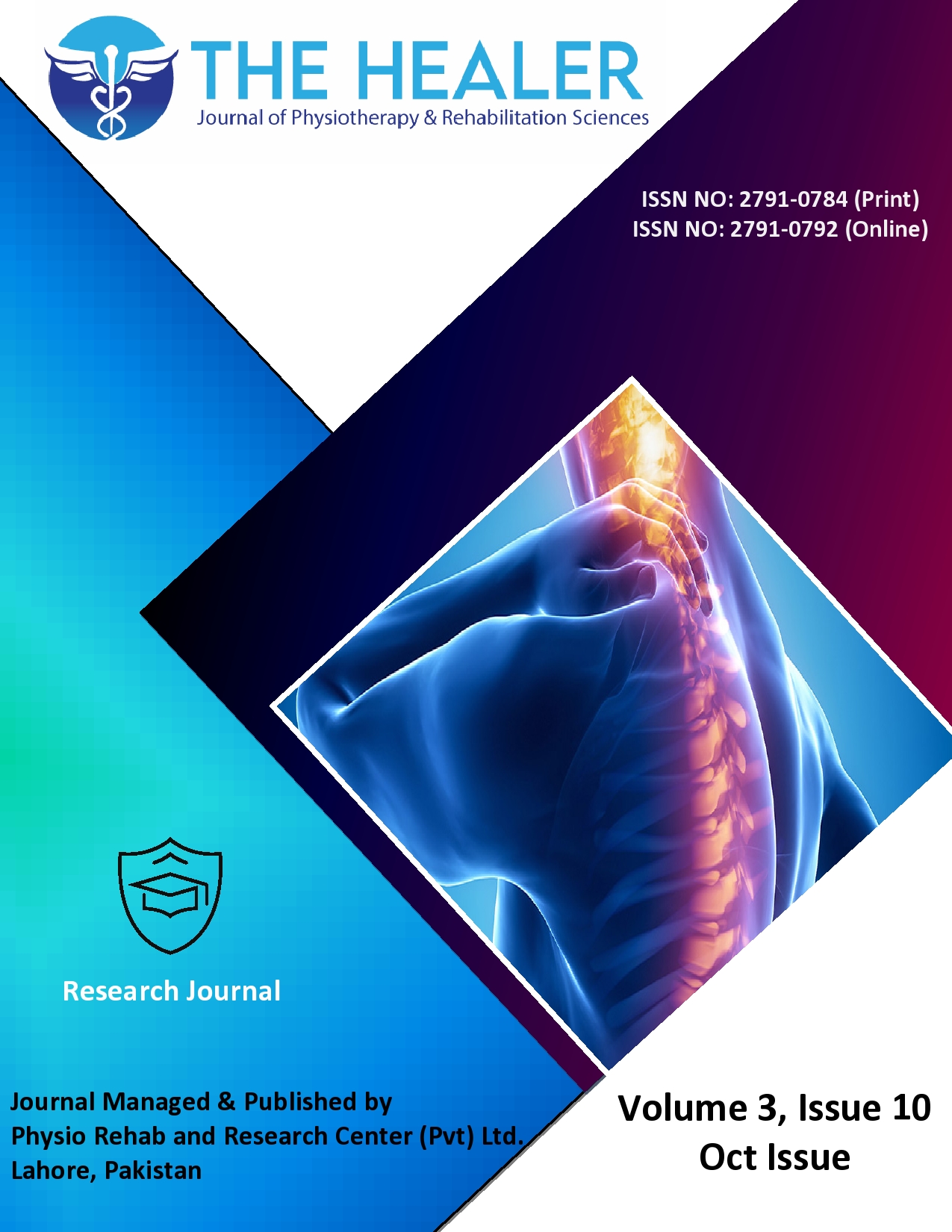Effects of Task-oriented Instructions on Intensity of Practice in Stroke Rehabilitation; A Quasi-Experimental Study
Effects of Task-oriented Instructions in Stroke Rehabilitation
DOI:
https://doi.org/10.55735/hjprs.v3i10.221Keywords:
intensity, rehabilitation, stroke, task-orientedAbstract
Background: The stroke or cerebrovascular accident has been caused by deprivation of blood supply to a part of the brain. Stroke has been recognized as a medical emergency that might lead to lasting functional disability and even death. Treatment management should be started as early as possible. Objective: To determine the effects of task-oriented instructions on the intensity of practice in stroke rehabilitation. Methods: This study is a quasi-experimental study in which a convenient sampling technique was employed to recruit participants in this study. The sample size was calculated using G power 3.9.1.2 version software using mean and standard deviation from the previously conducted study. Stroke patients aged between 30 to 80 years, either right or left or both sides paralyzed and with a stroke of the middle cerebral artery were recruited in this study. The patients were divided into two groups, patients in Group 1 were entertained with task-oriented instructions three times a week for four weeks and Group 2 were entertained with non-specific instructions three times a week for four weeks. Wolf motor function was used for collecting data, pre-test with non-specific instructions and post-test with task-oriented instructions. The test employed was an independent sample t-test to compare scores between groups before and after treatment. A paired sample t-test was employed to check the differences in scores before and after treatment. The p-value <0.05 was significant. Results: The average mean value for the score of the Wolf Motor Function test for both the groups’ pre and post was 60.17 and 66.23 respectively. The value calculated for the paired sample t-test during comparison was 9.24 with a p-value equal to 0.00 which was less than the reference value that was 0.05. Conclusion: This study concludes that task-oriented instructions help to increase the intensity of practice in stroke rehabilitation as compared to non-specific instructions.
Downloads
References
Kwakkel G, van Peppen R, Wagenaar RC, et al. Effects of augmented exercise therapy time after stroke: a meta-analysis. stroke 2004; 35(11): 2529-39. https://doi.org/10.1161/01.STR.0000143153.76460.7d
Schneider EJ, Lannin NA, Ada L, Schmidt J. Increasing the amount of usual rehabilitation improves activity after stroke: a systematic review. Journal of physiotherapy 2016; 62(4): 182-7.
https://doi.org/10.1016/j.jphys.2016.08.006
Lojovich J. Analysis of fMRI and Finger Tracking Training in Subjects with Chronic Stroke. Journal of Neurologic Physical Therapy 2004; 28(1): 49. DOI: 10.1097/01.NPT.0000284779.25179.8d
Scrivener K, Sherrington C, Schurr K. Amount of exercise in the first week after stroke predicts walking speed and unassisted walking. Neurorehabilitation and neural repair 2012; 26(8): 932-8. https://doi.org/10.1177/1545968312439628
Lang CE, MacDonald JR, Reisman DS, et al. Observation of amounts of movement practice provided during stroke rehabilitation. Archives of physical medicine and rehabilitation 2009; 90(10): 1692-8. https://doi.org/10.1016/j.apmr.2009.04.005
Kimberley TJ, Samargia S, Moore LG, Shakya JK, Lang CE. Comparison of amounts and types of practice during rehabilitation for traumatic brain injury and stroke. 2010.
DOI:10.1682/JRRD.2010.02.0019
Kaur G, English C, Hillier S. How physically active are people with stroke in physiotherapy sessions aimed at improving motor function? A systematic review. Stroke research and treatment 2012; 2012. https://doi.org/10.1155/2012/820673
Tyson SF, Woodward-Nutt K, Plant S. How are balance and mobility problems after stroke treated in England? An observational study of the content, dose and context of physiotherapy. Clinical rehabilitation 2018; 32(8): 1145-52. https://doi.org/10.1177/0269215518777789
Stewart C, McCluskey A, Ada L, Kuys S. Structure and feasibility of extra practice during stroke rehabilitation: A systematic scoping review. Australian Occupational Therapy Journal 2017; 64(3): 204-17. https://doi.org/10.1111/1440-1630.12351
Bayley MT, Hurdowar A, Richards CL, et al. Barriers to implementation of stroke rehabilitation evidence: findings from a multi-site pilot project. Disability and rehabilitation 2012; 34(19): 1633-8. https://doi.org/10.3109/09638288.2012.656790
Massie CL, Malcolm MP. Instructions emphasizing speed improves hemiparetic arm kinematics during reaching in stroke. NeuroRehabilitation 2012; 30(4): 341-50.
https://content.iospress.com/articles/neurorehabilitation/nre00765
Gauggel S, Fischer S. The effect of goal setting on motor performance and motor learning in brain-damaged patients. Neuropsychological Rehabilitation 2001; 11(1): 33-44.
https://doi.org/10.1080/09602010042000150
Nascimento LR, Caetano LC, Freitas DC, Morais TM, Polese JC, Teixeira-Salmela LF. Different instructions during the ten-meter walking test determined significant increases in maximum gait speed in individuals with chronic hemiparesis. Brazilian Journal of Physical Therapy 2012; 16: 122-7. https://doi.org/10.1590/S1413-35552012005000008
Hillig T, Ma H, Dorsch S. Goal-oriented instructions increase the intensity of practice in stroke rehabilitation compared with non-specific instructions: a within-participant, repeated measures experimental study. Journal of Physiotherapy 2019; 65(2): 95-8. https://doi.org/10.1016/j.jphys.2019.02.007
Kang H. Sample size determination and power analysis using the G* Power software. Journal of educational evaluation for health professions 2021; 18. DOI: https://doi.org/10.3352/jeehp.2021.18.17
Saif I. Role of physical therapy on quality of life and level of satisfaction among patients with stroke. The Healer Journal of Physiotherapy and Rehabilitation Sciences 2022; 2(1): 104-9.
DOI: https://doi.org/10.55735/thjprs.v2i1.41
Stanton R, Ada L, Dean CM, Preston E. Feedback received while practicing everyday activities during rehabilitation after stroke: an observational study. Physiotherapy Research International 2015; 20(3): 166-73. https://doi.org/10.1002/pri.1612
Durham K, Van Vliet PM, Badger F, Sackley C. Use of information feedback and attentional focus of feedback in treating the person with a hemiplegic arm. Physiotherapy Research International 2009; 14(2): 77-90. https://doi.org/10.1002/pri.431

Downloads
Published
License
Copyright (c) 2023 The Healer Journal of Physiotherapy and Rehabilitation Sciences

This work is licensed under a Creative Commons Attribution 4.0 International License.














